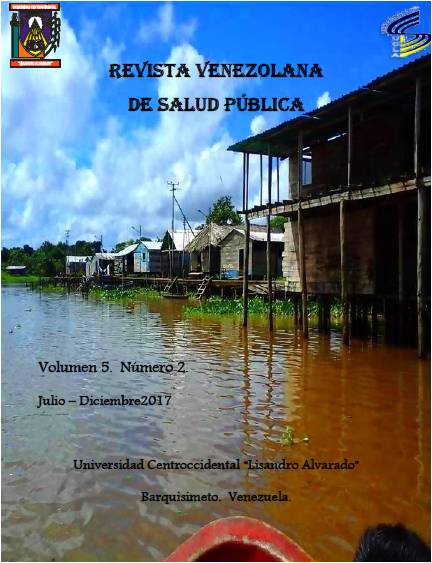Measurement of the Wingbeart Frequency of the Aedes aegypti PROVENIENTS FROM A REGION OF VENEZUELA
Keywords:
Aedes, wingbeat, vector, Venezuela, NaWaraoAbstract
In order to develop intelligent traps as vector control mechanisms for the prevention and reduction of metaxenic diseases, a physiological parameter is determined as the wingbeat frequency used for later characterization by genus of the Aedes aegypti mosquito in Venezuelan strains. For this, acoustic records were made with wild samples collected in rainwater reservoirs and emerged under controlled conditions in the laboratory. The recordings were made during one minute, in more than a hundred mosquitoes of this species and in both sexes, using a particle speed microphone connected to the audio input of a portable computer and a specialized program for acoustic records. A spectral analysis of the samples was carried out, determining that the average fundamental frequency of flutter for females corresponded to 454.78 ± 55.19 Hz and for males 688.39 ± 40.82 Hz, concluding that the groups were very separated in Its fundamental frequency, with which this parameter is a characteristic that can be used for the detection and classification of mosquitoes of this species, using artificial intelligence in capture devices for vector monitoring and control.
Downloads
References
2 Rifakis P., Gonçalves N., Omaña W., Manso M., Espidel A., Intingaro A., Hernández O. y Rodríguez-Morales A. 2005. Asociación entre las variaciones climáticas y los casos de Dengue en un hospital de Caracas, Venezuela, 1998-2004. Revista Perú medicina experimental salud pública 22: 183-190.
3 Valero Nereida. Virus Zika: ¿Otro arbovirus emergente en Venezuela? Invest. Clín [Internet]. 2015 Sep [citado 2017 Jun 27]; 56(3): 241-242. Disponible en: http://www.scielo.org.ve/scielo.php?script=sci_arttext&pid=S0535-51332015000300001&lng=es.
4 Göpfert M, Briegel H. y Robert D. 1999. Mosquito hearing: sound-induced antennal vibrations in male and female Aedes aegypti. The Journal of Experimental Biology 202: 2727–2738.
5 Mankin, R.; 1994. Acoustical Detection of Aedes Taeniorhynchus Swarms and Emergence Exoduses in Remote Salt Marshes. Journal of the American Mosquito Control Association 10: 302-308.
6 Ogawa, K y Kanda T 1986. Wingbeat frequencies of some anopheline mosquitoes of east Asia (Diptera: Culicidae).Japanese Sociey of Applied entomology and zoology 21: 430-435.
7 Gibson, G. y Russell, I. 2006. Flyng in Tune: Sexual Recognition in Mosquitoes. Current Biology 16: 1311-16.
8 Silva, D.; De Souza V., Batista G.; Keogh E. y Ellis,D. 2014. Applying Machine Learning and Audio Analysis Techniques to Insect Recognition in Intelligent Traps. Proceeding ICMLA '13 Proceedings of the 2013 12th International Conference on Machine Learning and Applications. 1 (99-104).
9 Cator, L.; Arthur, B.; Harrington, L. y Hoy, R. 2009. Harmonic Convergence in the Love Songs of the Dengue Vector Mosquito. Science 323:1077-79.
10 Arthur, B., Emr, K., Wyttenbach, R., y Hoy, R. 2014. Mosquito (Aedes aegypti) flight tones: Frequency, harmonicity, spherical spreading, and phase relationships. The Journal of the Acoustical Society of America, 135(2), 933–941. Diponible en:
https://www.ncbi.nlm.nih.gov/pmc/articles/PMC3985972/
11 Pan Amenrican Health Organization. Number of Reported Cases of Dengue and Severe Dengue (SD) in the Americas, by Country. [citado 2017 Jun 27] Disponible en: http://www.paho.org/hq/index.php?option=com_docman&task=doc_view&Itemid=270&gid=37782&lang=en
12 Stobbart, R. 1992. Selection of the yellow fever mosquito Aedes aegypti for cheap an easy maintenance without bloodmeals. Medicul arid Veteritiary Entomology 6: 82-87.
13 Warren, B. y Gibson, G. 2009. Sex Recognition Through Midflight Mating Duets in Culex Mosquitoes is Mediated by Acoustic Distortion. Current Biology 19: 485-491.
14 Hyatt, C. y Maughan, D; 1994. Fourier Analysis of wing beat signals: Assessing the effects of genetics alterations of flight muscle structure in Diptera. Biophysical Journal 67:1149-54.
15 Iams, A. 2012. Free flight of the mosquito Aedes aegypti. Physics. arXiv.org arXiv:1205.5260.
Published
How to Cite
Issue
Section
Derechos del/de autor/es a partir del año de publicación
Esta obra está bajo la licencia:
Creative Commons Reconocimiento-NoComercial-CompartirIgual 4.0 Internacional (CC BY-NC-SA 4.0)
Las opiniones expresadas por los autores no necesariamente reflejan la postura del editor de la publicación ni de la UCLA. Se autoriza la reproducción total o parcial de los textos aquí publicados, siempre y cuando se cite la fuente completa y la dirección electrónica de esta revista. Los autores(as) tienen el derecho de utilizar sus artículos para cualquier propósito siempre y cuando se realice sin fines de lucro. Los autores(as) pueden publicar en internet o cualquier otro medio la versión final aprobada de su trabajo, luego que esta ha sido publicada en esta revista.



